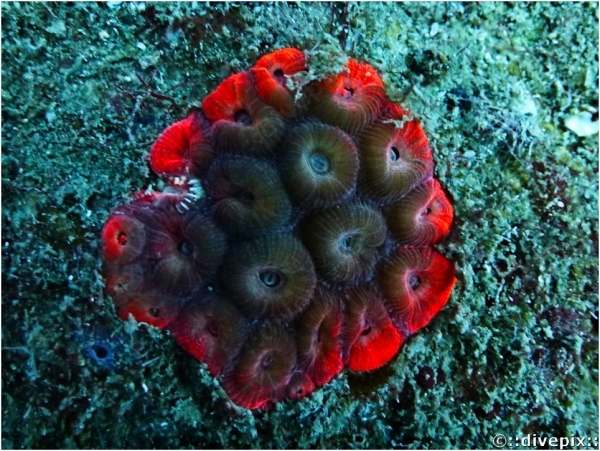| Aspect: | Colonies can grow into massive mounds (hence older Montastraea designation given by ), although eventual size depends on available development base. Of all the former Montrastaea species, cavernosa appears to feature the most prominent and largest corallites (up to 10mm in diameter) with the tightest array of corallites. Corallites also appear to feature the most cavernous mouth cavities. The former Montrastaea species included Montrastaea annularis, faveolata and franksi. They are all now known as Orbicella annularis, faveolata and franksi. Only Cavernosa remained Montastraea. |
| Population: | Abundant. |
| Notable feature: |
Colours, including brown (most common in Western Guadeloupe), green and sometimes grey - depend on zooxanthellae types which, depending on content of particular proteins, can even cause red fluorecence as seen in title photograph - in total absence of special fluo lights. Zooxanthellae are microscopic photosynthetic algae that live in symbiosis with corals. The latter provide shelter in exchange of which the zooxanthellae supply certain nutriments (including glucose and aminoacids relutling from photosynthesis) that enable them to eventually produce the calcium carbonate used to form their structure. |
| Environment: | Depths of between a few metres to 40 metres. |
| Behaviour: | Polyps extend at night, revealing a variety of colours, including bright greens. |





Great Star Coral
- Désignation anglaise: Grand Corail Etoilé (aniciennement Corail Montagneux à Grands Polypes)
- Désignation latine: Montastraea cavernosa
- Désignation créole: -
- Famille en latin: Montastraeidae (ex Faviidae)
- Taille (cm): 15-250
View the embedded image gallery online at:
https://divepix.webdhb.com/index.php/fr/animalia/cnidarians/stony-corals/201#sigProIdd9ce2a3018
https://divepix.webdhb.com/index.php/fr/animalia/cnidarians/stony-corals/201#sigProIdd9ce2a3018




